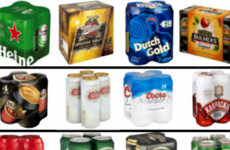Welcome to Skin Deep with Louise McSharry, my opportunity to put years of obsessing over beauty products and techniques to good use. I won’t tell you something is good if it’s not. I won’t recommend products I haven’t actually tried. As the magical sitar in Moulin Rouge said, I only speak the truth.
Once upon a time if someone had handed you a bottle of what looked like green foundation and told you to put it on your face, you would have told them their Wicked Witch of the West fetish was showing.
These days, you’d simply nod and smile. ‘Ah… colour correcting primer,’ you’d say, as you took the bottle from them. Colour correction is everywhere now, with almost every high street brand including such products in their offerings and high-end brands jumping on the trend too.
But what do you actually do with these products? What colour should you be using? Do you put them all over your face? Do they actually work? FOR THE LOVE OF GOD SOMEONE HELP! Oh wait, sorry, that’s the whole point of this column. I’m here to do just that.
First, the basic principles. Colour correction essentially uses basic colour theory to assist you with evening out your complexion. For example, red is opposite green on the colour wheel, so the two colours essentially cancel each other out. Thus, some green concealer is often helpful when trying to conceal angry red blemishes or Rosacea.
Purple is opposite yellow, so is good for eliminating unwanted yellow undertones, or brightening the face generally.
Salmon or peachy coloured concealers are good for cancelling out dark circles, because the blue-y/green-y/purple-y colours are balanced by the pink-y/orange-y/yellow-y elements to the peach (and they’re opposite each other on the colour wheel). Yellow is opposite blue, so is a good one for covering blue bruises or veins. Orange is good for covering dark circles on deeper skin complexions.
The real question is, do you need to do this? I would argue that most people don’t. Our skin isn’t meant to be perfectly even in colour, despite the current trend for applying a heavy base which leaves you with a totally blank canvas. In truth, it’s natural to have different colours in our face. Having said that, there are cases in which colour correction is appropriate, and obviously if there is discolouration on your face that is bothering you then hop aboard the colour correction train!
You probably know already if there is an area of your face you feel you feel could benefit from this technique, but if not, take a good look at yourself in natural light. If you look relatively even, then you’re probably grand.
However, if you notice patches that are completely at odds with the rest of your face, try to identify the undertones. Once you’ve done that match them with the information above to assess what colour you need to neutralise what’s there. This doesn’t mean you need to be like Picasso with a palette intricately dabbing seven different colours all over your face, although some YouTubers revel in this practice. In fact, you may feel like your face is pretty ok. It probably is
If your current makeup is doing a grand job of evening out your skin tone, then you probably don’t need to buy a colour correcting product. However, if you feel you do, it’s time to assess what type of colour correction product you need.
As I mentioned, there are lots of options these days, but the most common are coloured concealers and coloured primers. As you might expect, concealers are better for neutralising small patches of colour, while a primer will have an overall effect.
For example, a green pot of concealer would be great for covering spots, while a primer would sort out larger patches of red. I’m not a huge believer in primer as a rule, I think well hydrated skin doesn’t need it. I definitely don’t think you need to apply a coloured primer all over your face, because not all of your face requires neutralising.
Having said that, at this time of year some people with dry skin will benefit from it (otherwise your skin could mistake foundation for moisturiser and soak it all up), so if you choose to use a coloured primer, try to use it sparingly in the areas where it’s required. Whenever you use a primer, take care not to overapply and give it a few minutes to sink into the skin.
Makeup won’t go on nicely over too much of any product. My favourites of the colour correcting primers I’ve tried are Clarins SOS Colour Correcting Primers, which are light and apply nicely, or NYX Professional Makeup Colour Correcting Liquid Primer.
If you’re using coloured concealer, apply it to the necessary areas and then be careful pat or dab on any foundation rather than swiping it on. This way the concealer will stay where you need it. My favourites are Urban Decay’s Naked Skin Colour Correcting Fluid or Max Factor Colour Correcting Sticks.
New Product
I was a fan of YSL Touche Eclat foundation for years, but found myself falling slightly out of love with it after they changed the formulation a couple of years ago. Now, they’ve launched Touche Eclat All-In-One-Glow, which promises to give you ‘perfect medium coverage and a flawless glow’. Count me in!
Want to get a notification every week when Skin Deep is published? Of course you do! Just send us a WhatsApp saying ‘Skin Deep’ to 083 8120901, and add our number to your contacts as DailyEdge. (If you don’t add us, we can’t message you :( ) We’ll never spam you or share your personal details with anyone, and you can unsubscribe at any time.













COMMENTS